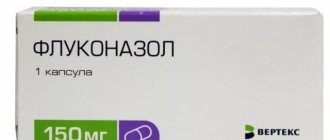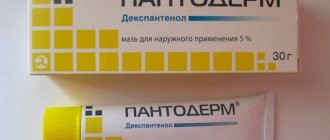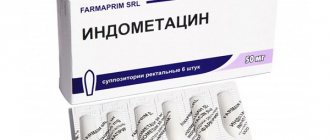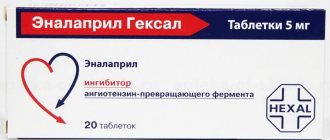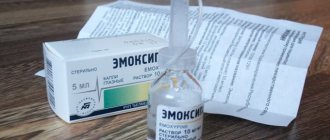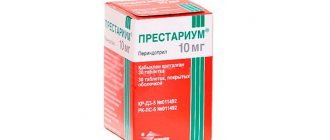Betadine is a powerful disinfectant and antiseptic. Effective against viruses, fungi, cocci, E. coli and other types of pathogens of pathological infection, except Koch's bacillus.
After introducing the Betadine suppository into the vagina, the active substance begins to decompose, releasing iodine, due to which all pathogens, viruses, and fungi are destroyed. The mechanism of action of the main active substance of the suppository is its binding to the proteins of the cells of the infectious pathogen, which leads to their coagulation (clotting and death).
The drug does not have a toxic effect, but it is not recommended to use it without a doctor’s prescription.
Pharmacological properties of the drug Betadine
Antiseptic drug with a broad spectrum of antimicrobial action against bacteria, some viruses, fungi and protozoa. Upon contact with the skin and mucous membrane, iodine is gradually released and has a bactericidal effect. Iodine reacts with oxidizable groups of amino acids that are part of the enzymes and structural proteins of microorganisms, inactivating or destroying these proteins. The action develops in the first 15–30 s, and the death of most microorganisms in vitro occurs in less than 1 min. In this case, the iodine becomes discolored, and therefore a change in the intensity of the brown color is an indicator of its effectiveness. When a complex is formed with the polyvinylpyrrolidone polymer, iodine largely loses the local irritating effect characteristic of alcohol solutions of iodine, and therefore is well tolerated when applied to the skin, mucous membranes and affected surfaces. Due to the mechanism of action, resistance to the drug, including secondary resistance, does not develop with long-term use. Prolonged application of the drug to large wound surfaces or severe burns, as well as to mucous membranes, can lead to the absorption of a significant amount of iodine. As a rule, due to long-term use of the drug, the concentration of iodine in the blood quickly increases. The concentration returns to the initial level 7–14 days after the last use of the drug. The absorption and renal excretion of povidone iodine depends on its molecular weight, and since it ranges from 35,000–50,000, retention of the substance in the body is possible. It is excreted from the body mainly by the kidneys. The volume of distribution is approximately 38% of body weight, the half-life after vaginal use is about 2 days. Typically, plasma total iodine levels are approximately 3.8–6.0 μg/dL and inorganic iodine levels are 0.01–0.5 μg/dL.
Does Betadine help with thrush?
Betadine in suppositories has a wide spectrum of action, therefore it is used for acute and chronic thrush, bacterial and mixed infections of the vagina.
The effect of the medicine is due to the povidone-iodine it contains. After administration, the suppository melts, evenly covering the mucous membrane and releasing active iodine. Next, it combines with the amino acids of Candida fungi (other protozoa, viruses, bacteria), which leads to the destruction of the cells of the latter.
With the constant use of Betadine for thrush, resistance of the pathogen to the active substance is not observed. Other advantages of the drug:
- by normalizing acidity, it restores the microflora (lactobacillus) of the vagina, which reduces the risk of relapses in the future;
- quickly eliminates the symptoms of thrush;
- does not cause irritation to the mucous membrane due to the water-soluble base;
- acts locally without having a negative effect on the body. However, with prolonged use, the active substance may enter the blood and increase the concentration of iodine in it. In women without diseases or pathologies of the thyroid gland, everything returns to normal within a couple of weeks.
For those planning a pregnancy, it is not advisable to use Betadine, since it has spermicidal (contraceptive) properties.
When should you use Betadine suppositories?
If you look at the instructions that we will find in the box, you can get complete information about when you should resort to using this medicine:
- Vaginitis, that is, inflammation in a woman’s vagina. It can be in both acute and chronic forms;
- Bacterial vaginosis, which means the absence of an inflammatory process, but there is an altered vaginal microflora;
- Candidiasis is also an infection that affects the mucous membrane and is caused by fungi from the Candida group;
- Trichomonosis, that is, inflammation of the genitourinary system, which is sexually transmitted;
- An infection that occurs immediately after treatment with steroids or antibiotics;
- Prophylaxis is required before surgery or diagnosis.
Composition and mechanism of action of the drug
The active components of suppositories for thrush are iodine and polyvinylpyrrolidone. After insertion into the vagina, the suppository begins to melt, iodine reacts with cellular proteins, as a result of which the fungus dies.
The use of Betadine for thrush allows you to eliminate the accompanying pathologies that are of a mixed infectious nature. It has been established that pathogenic microflora is not capable of developing resistance to the active components of this drug, which determines its effectiveness.
During long-term treatment of thrush, this medication helps restore the vaginal microflora, which eliminates the need to take additional medications that promote regeneration of the mucous membrane.
The composition and mechanism of action of the drug allow its use in the early stages of pregnancy. This is due to the fact that the concentration of iodine in the blood increases only during long-term treatment, and this level can be maintained for a short period of time.
You can learn more about suppositories for thrush for pregnant women from our separate article on the website.
Special instructions for the use of Betadine
The dark brown color of Betadine indicates the effectiveness of the solution; a decrease in color saturation is a sign of a decrease in the antimicrobial activity of the drug. Under the influence of light or a temperature of 40 ° C, the solution decomposes. The antimicrobial effect of Betadine solution occurs at a pH of 2 to 7. The use of povidone-iodine may reduce the absorption of iodine by the thyroid gland, which may affect the results of some studies (thyroid scintigraphy, determination of protein-bound iodine, diagnostic procedures using radioactive iodine). When planning these procedures, it is necessary to take a break from using povidone-iodine for at least 1–4 weeks. The oxidizing effects of Povidone-iodine can cause corrosion of metals, while plastic and synthetic materials are generally not sensitive to Povidone-iodine. In some cases, a change in color is possible, which is usually restored. Povidone-iodine is easily removed from textiles and other materials with warm water and soap. Stains that are difficult to remove should be treated with ammonia or sodium thiosulfate solution. During treatment with the drug, breastfeeding should be stopped. The solution is not intended for oral administration. During preoperative disinfection of the skin, it is necessary to ensure that no residues of the solution remain under the patient (due to the possibility of skin irritation). Since the development of hyperthyroidism cannot be excluded, long-term (14 days) use of Povidone-iodine or its use in significant quantities over large surfaces (10% of body surface) in patients (especially elderly) with latent thyroid dysfunction is permissible only after careful comparison of the expected benefits and possible risk. These patients require monitoring for early signs of hyperthyroidism and proper evaluation of thyroid function, even after discontinuation of the drug (for a period of up to 3 months). Long-term use of the drug can cause irritation and sometimes severe skin reactions. If signs of irritation or hypersensitivity appear, application of the drug should be discontinued. Significant amounts of iodine can cause hyperthyroidism in patients with thyroid dysfunction. Therefore, they are limited in the use of ointment or solution according to the time and area of the skin surface being treated. If symptoms of hyperthyroidism occur during treatment, thyroid function should be monitored. High doses of iodine should be avoided in infants and young children because their skin is highly permeable and they are more likely to be sensitive to iodine, increasing the risk of developing hyperthyroidism. Povidone-iodine should be used in low doses in these patients.
If necessary, thyroid function should be monitored. Particular caution should be taken when using the drug regularly in patients with previously diagnosed renal failure. Regular use of the ointment should be avoided in patients receiving lithium preparations. Regular use of povidone-iodine during pregnancy and lactation is possible only according to absolute indications and in low doses, since absorbed iodine penetrates the placental barrier and can pass into breast milk. The level of povidone-iodine in milk is higher than its level in blood serum
Use of this drug may cause transient hyperthyroidism in the fetus and newborn. In these cases, testing of the child's thyroid function may be necessary. Avoid accidental exposure of the drug to the mouth or gastrointestinal tract, especially in children.
Contraindications
Betadine suppositories should not be prescribed to women with the following conditions:
- dysfunction of the thyroid gland (nodular colloid goiter, endemic goiter and Hashimoto's thyroiditis, hyperthyroidism);
- thyroid adenoma;
- Dühring's dermatitis herpetiformis;
- simultaneous use of radioactive iodine;
- children under 8 years of age;
- hypersensitivity to iodine and other components of the drug.
The drug should be used with caution during pregnancy and lactation (breastfeeding).
Instructions for use
The medicine is developed for topical use. The affected area should be thoroughly cleaned before use.
Apply the ointment in a thin layer with light rubbing movements. If the site of the disease becomes wet, an occlusive dressing should be applied. Frequency of application – three times a day, use until the affected areas of the epidermis are completely restored. The duration of therapy is no more than fifteen days.
Children can be used from birth to treat the navel area and diaper rash, but only as a last resort. Before this, it is necessary to examine the condition of the thyroid gland. For children from one to eighteen years of age, the drug is used as an antiseptic for microtrauma of the skin, stomatitis, and infection of the dermis.
Interesting to know
According to reviews, the product is effective for treating acne. In this case, the product must be applied pointwise.
The drug should not be used by pregnant women in the second and third trimesters. It should only be used when absolutely necessary after consulting a doctor. If you use the drug yourself without the approval of a doctor, there may be a risk of developing a congenital pathology in the child.
Methods of application
Before starting to use Betadine, it is recommended to consult a doctor and undergo a comprehensive examination. After identifying the causative agents of the pathological process and their sensitivity to the active component of the drug, therapy can begin. Before using suppositories, solution or ointment, you must carefully study the instructions, paying special attention to possible contraindications, method of use, and unwanted side reactions.
If during Betidon therapy the clinical picture worsens or other symptoms appear, you must stop using the medication and consult your doctor again.
Candles
Suppositories are intended for intravaginal administration , 1 pc. at night for 1 week. For severe, generalized infections, your doctor may suggest a course of treatment for up to 14 days. Persistent infections and severe thrush may require the use of suppositories twice daily.
The medicine is used in the following way:
- the drug is removed from the protective packaging;
- the candle is wetted;
- lie on your back, bend your knees, inject the medicine deep into the vagina;
- The drug is used before going to bed; after administering the medication, you must lie down for at least 30-40 minutes so that the active substance is evenly distributed over the walls of the vagina and begins to have a therapeutic effect;
- Betadine must be used every day, including during menstrual bleeding.
Brief overview of analogues
Betadine comes in many forms. It has analogues of all forms, both in composition and in its therapeutic effect, which can replace Betadine ointment. Analogues of Betadine ointment:
- Aquazan. Available in the form of a solution for external use. Sold in several quantities. Produced by a Russian pharmacological company. It contains povidone-iodine and is used for injuries, infectious diseases, skin lesions, and for disinfection.
- Betadine, the main component is povidone-iodine. Available in the form of a solution for external use. Produced by a Serbian company. Used for infections of the mouth, pharynx, vaginitis, fungal infections. Accelerates the regeneration of wounds and microtraumas.
- Brownodin. The composition also contains povidone-iodine, the product is available both in the form of a solution and in the form of an ointment. Must be used externally, applied to affected areas. Produced by a Swiss company.
- Vokadin. Povidone-iodine in the composition has a disinfecting effect, destroys various types of infections and accelerates skin regeneration. Available in the form of vaginal tablets. Manufactured by an Indian company.
- Iodine is available in the form of a solution for external use, produced by a Russian company.
- Iodovidone. Available in several forms - aerosol, vaginal suppositories, powder. Produced by a Russian company.
- Iodoxide, Iodosept. Available in the form of vaginal suppositories. Manufacturer – Russia.
Among the analogues in ointment form for the drug Betadine, Stellanin and Stellanin-PEG ointments are noted. The iodine content is three percent. In addition to the ointment form, they are in the form of drops for oral administration. Produced by a Russian manufacturer.
Indications
Betadine is used in complex therapy of the following diseases and conditions:
- vaginitis;
- prevention of secondary infections after unprotected sexual intercourse, visiting public swimming pools, etc.;
- preliminary stage before the introduction of intrauterine devices and planned gynecological surgery;
- therapy for bacterial, viral, fungal skin infections, prevention of superinfections.
The drug is also used to treat bedsores, trophic skin lesions, diabetic feet, as well as in dental practice.
Candles
The use of Betadine suppositories for thrush can reduce the symptoms of vaginal candidiasis: itching, burning, hyperemia, swelling. The drug is used in the complex treatment of acute and chronic vaginal infections:
- colpitis;
- mixed vaginal infection;
- nonspecific lesions caused by bacteria, gardnerella, trichomonas, herpes;
- vaginal candidiasis, provoked by fungi of the genus Candida, as well as prolonged use of antibiotics and corticosteroids.
Pharmacological effect
The drug is a complex compound of iodine and polyvinylpyrrolidone (PVP). PVP, an inert synthetic polymer, acts as a carrier. Accordingly, all pharmacological properties of the drug are associated only with iodine, which belongs to the group of halogen antiseptics; The spectrum of action of iodine extends to gram-positive and gram-negative bacteria, fungi, protozoa, treponemes, viruses and acid-fast bacteria.
The bactericidal effect of iodine is explained by its strong oxidizing properties; it actively interacts with the amino acids of proteins, as a result of which the quaternary structure of the protein changes and its catalytic and enzymatic activity is lost. Basically, iodine disrupts the structures of bacterial transmembrane proteins and enzymes that do not have membrane protection. The concentration of active iodine in Betadine is 0.1-1%. Suppositories are made on a water-soluble basis and do not irritate the mucous membrane. When applied topically, there is almost no resorption of iodine from the mucous membrane.
Composition and pharmacological action
Betadine is sold in the form of elongated brown suppositories for intravaginal use. One candle contains:
- 200 mg of povidone-iodine (corresponds to 24 mg of iodine) – the main substance;
- polyethylene glycol is an excipient.
In pharmacies you can find Betadine in packages with 1-2 blisters, each of which contains 7 suppositories.
Betadine is inserted into the vagina and actively begins to decompose. During this, iodine enters the tissue, actively destroying all harmful microorganisms, viruses and fungi.
Povidone-iodine works simply: its molecules bind to the proteins of infectious agents and this leads to their coagulation and death.
Since povidone-iodine molecules are quite large in size, they are not immediately absorbed into the blood and their effect is local. The active substance does not interact with the mucous membranes during vaginal administration of suppositories.
Despite the fact that the drug molecules do not penetrate very deeply into the tissues, its therapeutic effect lasts for a longer period due to its slow release. The drug is simultaneously:
- antiseptic;
- disinfectant;
- antifungal;
- antiprotozoal action.
The drug does not have a toxic effect, but its use without a doctor’s prescription is not recommended.
Betadine or Hexicon
Both drugs are not analogues of each other. Betadine contains Povidone-Iodine. Release form: ointment, solution, vaginal suppositories. The active ingredient of Hexicon is Chlorhexidine. Available in the form of tablets and vaginal suppositories. The drug is indicated during pregnancy, lactation and pediatric gynecology. You also need to know that the dosage form of vaginal tablets Hexicon does not increase the amount of vaginal discharge when used. The drug is indicated for the following processes:
- prevention of sexually transmitted infections (including gonorrhea, syphilis, trichomoniasis, chlamydia, ureaplasmosis, genital herpes);
- prevention of infectious and inflammatory complications in obstetrics and gynecology (before surgical treatment of gynecological diseases, before childbirth and abortion, before and after installation of an intrauterine device, before and after diathermocoagulation of the cervix, before intrauterine examinations);
- treatment of bacterial vaginosis, colpitis (including nonspecific, mixed, trichomonas).
Betadine suppositories can only be used by children over 8 years of age.
Pregnant and lactating women are prescribed with caution. Both drugs are indicated without a doctor's prescription
The choice is made by a specialist. Both are used to prevent sexually transmitted infections (use no later than 2 hours after unprotected sexual intercourse).
The country of origin of Betadine is Hungary. Hexicon is manufactured by the Russian Federation. Hexicon is more expensive than Betadine. Price per package from 218 rub.
Betadine or Hexicon. Photo: vchemraznica.ru
Indications for the use of Betadine suppositories
Betadine can be used not only to treat thrush in women. It is also prescribed for diseases of the genital organs:
- bacterial vaginosis;
- menstrual herpes;
- the spread of infectious processes in the vagina, which have an acute or chronic form;
- the appearance of mycotic pathologies due to the use of steroid medications.
In addition, the drug is used in case of vaginal infection caused by Trichomonas, as well as after transvaginal surgery.
Treatment with Betadine suppositories for thrush should only be carried out under the supervision of a doctor, since their use may be accompanied by a burning sensation. Sometimes this is a normal reaction of the body to the administration of an active substance, but in some cases it may indicate the development of side effects. Self-medication of candidiasis threatens to worsen the disease and cause more severe symptoms.
Use of the drug Betadine
Solution The drug is intended for external use in diluted and undiluted form. The drug should not be diluted with hot water. Only short-term heating to body temperature is permissible. Undiluted solution is used to treat hands and skin before surgical operations, bladder catheterization, injections, punctures, etc. Solutions can be used 2-3 times a day. Hygienic hand disinfection: 2 times 3 ml of undiluted solution - each dose of 3 ml is left on the skin for 30 s. Surgical hand disinfection: 2 times 5 ml of undiluted solution - each dose of 5 ml is left on the skin for 5 minutes. To disinfect the skin, the undiluted solution is left after use until it dries. According to the above indications, the solution can be used after dilution with tap water. During surgical operations, as well as during antiseptic treatment of wounds and burns, isotonic sodium chloride solution or Ringer's solution should be used to dilute the drug. The following dilutions are recommended:
Indication | Breeding | Volume of preparation/volume of dissolving solution |
| Wet compress | 1:5–1:10 | 200–100 ml/1 l |
| Local and sitz baths | 1:25 | 40 ml/1 l |
| Preoperative bath | 1:100 | 10 ml/1 l |
| Hygienic bath | 1:1000 | 10 ml/10 l |
| Vaginal douching Insertion of an IUD Irrigation of the perineum Irrigation in urology | 1:25 | 4 ml/100 ml |
| Irrigation of chronic and postoperative wounds | 1:2–1:20 | 50 ml–5 ml/100 ml |
| Irrigation in orthopedics and traumatology Irrigation during operations in the oral cavity | 1:10 | 10 ml/100 ml |
The solution should be diluted immediately before use.
Ointment Preparation for local use. To treat infection: apply 1-2 times a day. The duration of treatment is no more than 14 days. To prevent infection: apply 1-2 times a week as long as needed. The affected skin surface should be cleaned and dried, and a thin layer of ointment should be applied. A bandage can be applied to the skin treated in this way. Suppositories The suppository is removed from the shell and, after moistening, is inserted deep into the vagina. During the treatment period, the use of sanitary pads is recommended. Dosage: One vaginal suppository is inserted deep into the vagina in the evening before bed. The drug should be used daily (including during menstruation). In case of insufficient effectiveness, the course of treatment can be continued, and the dose can be increased to 2 vaginal suppositories daily. The duration of treatment depends on the results of therapy, usually it is 7 days.
Suppositories for thrush and their effectiveness
The optimal solution to a problem such as thrush is the use of vaginal suppositories. With the help of suppositories, all symptoms of candidiasis are eliminated in a short period of time, namely:
- Itching and burning of the labia;
- Swelling and irritation of the vaginal mucosa;
- Discharge;
- Pain during urination and sexual intercourse.
The effectiveness and speed of action of such drugs as suppositories for thrush are determined by their active component. Suppositories penetrate deep into the source of infection, so after the first use the woman will feel relief from her condition. Such drugs for thrush are not just antifungal agents for treatment, but are also used for prevention.
Thrush suppositories are very easy to use. They should be administered while lying on your back just before bedtime. The course of treatment is prescribed to each girl individually. As a rule, it is at least a week. It is important not to stop using the suppository at the first relief, but to complete the entire course of therapy to the end.
It is better not to use suppositories during menstruation, as there will be no positive result. The disadvantages include the fact that at normal body temperature they begin to melt. During sleep, this process causes virtually no discomfort. But in the morning the suppository begins to flow out, staining the laundry. Sometimes therapy requires complex treatment, using other antifungal agents.
Instructions for use Betadine method and dosage
The ointment is applied externally. A thin layer of the product is applied to the affected area of the skin 2-3 times a day. Occlusive dressings can be applied on top.
Before administration, the suppository is moistened with water. Inserted deep into the vagina at night. For acute vaginitis, the dosage is 1 sup. 1-2 times a day. The duration of treatment is 7 days. For chronic and subacute vaginitis, 1 supp. 1 time a day before bedtime. Duration of therapy is 2 weeks. During the course of treatment, sanitary pads should be used. It is not recommended to stop taking suppositories during menstruation.
The solution is used to treat the skin and mucous membranes. It should not be diluted. The product is washed over damaged areas of the skin and used as a wet compress. A 10% solution is also used in drainage systems. To do this, the product should be diluted with water (10-100 times) immediately before use. The drug should not be stored in diluted form.
Dosage of suppositories
Betadine should only be used after consulting a doctor. Based on the examination, the specialist will determine the indications for the use of Betadine, as well as the course of the disease, and then prescribe the exact dosage and duration of treatment.
- In acute cases of vaginitis and other diseases, depending on the degree of damage, 1-2 Betadine suppositories are prescribed per day. The course of treatment is a week;
- In the chronic course of the disease, 1 suppository is prescribed for 10-14 days. In some cases, the course of treatment may be longer, but usually no more than 20 days;
- In order to prevent the occurrence of infectious diseases, before various gynecological procedures, as well as after unprotected sexual intercourse, 1 suppository is prescribed before bedtime for 5 days.
special instructions
When using betadine suppositories, you should keep in mind:
- The iodine contained in this drug may cause incorrect test results that are aimed at detecting blood in stool or urine;
- The results of diagnostics carried out in the thyroid gland may be distorted. For the picture to be true, you need to stop consuming the drug some time before the tests;
- If the patient receives medications containing lithium, then suppositories should not be used regularly;
- They contain certain substances that may be harmful if the patient is planning a pregnancy in the near future.
my basket
Apteka84.kz is an online pharmacy that offers its customers medicines, medicinal and decorative cosmetics, dietary supplements, vitamins, baby food, intimate products for adults, medical equipment and thousands of other medical and cosmetic products at low prices. All data presented on the Apteka84.kz website is for informational purposes only and is not a substitute for professional medical care. Apteka84.kz strongly recommends that you carefully read the instructions for use contained in each package of medicines and other products. If you currently have any symptoms of the disease, you should seek help from a doctor. You should always tell your doctor or pharmacist about all the medicines you take. If you feel you need further help, please consult your local pharmacist or contact our GP online or by telephone.
© 2012 Pharmacy 84.
Drug interactions
To avoid unpleasant side effects and not worsen your health, you need to be aware of the interactions of povidone-iodine with other medications. The instructions say the following:
- Betadine is incompatible with medications containing mercury. This increases the risk of formation of alkaline mercury iodide.
- The disinfectant may react with unsaturated organic compounds and proteins. This effect is compensated by increasing the dosage of povidone-iodine.
- Patients being treated with lithium are advised to avoid prolonged therapy with the solution, especially on large affected areas.
- The interaction of iodine with hydrogen peroxide, enzyme medications (containing tauloridine and silver) can cause a mutual decrease in the effectiveness of the drugs.
Side effects, overdose
The composition of the drug makes it quite easy to digest, without irritating effects or side effects. Povidone-iodine is much less irritating than concentrated regular iodine, but can still cause local irritation. Side effects of the drug also include:
- contact dermatitis;
- itching;
- allergic reactions;
- negative effect on sperm.
If the patient experiences some of these symptoms, you should stop taking the medication and contact your doctor. Due to the negative effect of iodine on sperm, it should not be used during pregnancy planning or the period of immediate conception.
An overdose of the drug is possible with repeated use of povidone-iodine, as well as taking suppositories orally. In the second case, acute intoxication may begin with the following symptoms:
- metallic taste;
- increased salivation;
- burning or pain in the nasopharynx;
- eye irritation and swelling;
- skin manifestations;
- disturbances in the gastrointestinal tract;
- diarrhea;
- labored breathing;
- pulmonary edema;
- metabolic disorder;
- kidney dysfunction.
If you use the drug for a long enough time without breaks, dysfunction of the thyroid gland and subsequent problems may occur. If you suspect an overdose, you should immediately consult a doctor or call an ambulance.
As soon as the drug has been accidentally ingested, you should ingest foods containing large amounts of starch or protein (dissolve a large amount of starch in water or milk) and immediately go to the emergency room of the nearest hospital.
Contraindications and special instructions
The drug and any analog substitute for Betadine should not be used in the following cases:
- pathological changes in the thyroid gland;
- treatment with radioactive iodine;
- acute renal failure;
- during pregnancy and lactation (use is permissible only with the permission of a doctor);
- childhood;
- chronic dermatitis;
- hypersensitivity to the components of the composition.
Betadine is allowed for use by pregnant women only in the 1st trimester. At a later date, consultation with a specialist will be necessary.
The use of the medication or its analogue may cause an allergic rash in the form of blisters. To neutralize this effect, you should stop taking it.
Uncontrolled use of Betadine suppositories and analogues can cause disruption of the vaginal microflora. With such dysbacteriosis, microorganisms will constantly provoke an inflammatory process. The instructions for use of Betadine do not allow the possibility of driving during the period of treatment.
Betadine is not prescribed to patients being treated with lithium-based medications. Women who use the product to treat vaginal infections need to use panty liners and take care of personal hygiene, because side effects in the form of cheesy discharge may occur.
Sometimes a cheaper substitute is prescribed instead of Betadine suppositories. However, whether a particular drug is suitable can only be determined by the attending physician, based on the indications.
Sources:
Vidal: https://www.vidal.ru/drugs/betadine__110 GRLS: https://grls.rosminzdrav.ru/Grls_View_v2.aspx?routingGuid=a6f6a816-0d1f-4e35-b3f5-07fe0693985c&t=
Found a mistake? Select it and press Ctrl + Enter
During pregnancy and lactation
It has been proven that iodine does not negatively affect the unborn baby and does not cause mutations. However, the use of vaginal suppositories in the 1st trimester of pregnancy is not recommended by gynecologists. The substance actively penetrates the placenta, and in large dosages can negatively affect the thyroid glands of the fetus. The use of the drug at a later stage of pregnancy is allowed after the doctor has assessed all possible risks.
When treating with Betadine during pregnancy, constant monitoring is carried out: tests are taken, the condition of the thyroid gland of the mother and child is checked. During lactation, treatment with suppositories is possible, but only under the strict supervision of a specialist. The medicine almost does not enter the bloodstream, so the active ingredients of the drug are not able to penetrate to the newborn and cause harm.
special instructions
There are a number of special instructions that are specified in the instructions for the drug. If you do not adhere to them, side effects and complications of the pathology that is being treated may occur. Cautions and tips for using an antiseptic drug:
- If a person has problems with the functioning of the thyroid gland, then the product can only be used under the supervision of a specialist.
- Regular use of povidone iodine should be cautious when the patient has chronic renal failure.
- After the drug dries, a colored film forms on the area of the skin or mucous membrane. This colored layer remains until all active iodine has left the body. When the film disappears, the drug ceases its effect.
- Do not disinfect bites of domestic/wild animals or insects.
- Areas of skin and tissue after treatment with Betadine have a dark brown color. Discoloration can be easily achieved with plain soap and water. If stains are difficult to remove, you can use an ammonia solution.
- It is necessary to ensure that no excess solution remains under the bedridden patient, otherwise this will lead to severe skin irritation.
- If the disinfectant gets inside, the stomach is washed with diluted sodium thiosulfate (5%).
Overdose
When self-medicating and when the dosage is exceeded, the following symptoms may occur:
- Vaginal dysbiosis. In this case, discharge with an unpleasant odor appears. This may cause recurrence of the disease or the addition of other infections;
- If a woman has a disease associated with dysfunction of the thyroid gland, thyrotoxicosis may occur.
- Rapid pulse;
- Labored breathing;
- Skin rashes.
With a severe overdose of Betadine, iodine poisoning occurs. In this case, a metallic taste appears in the mouth, burning and even swelling of the pharynx, and impaired renal function.
If symptoms of overdose occur, you should urgently visit a doctor to assess your condition and prescribe appropriate treatment.
To eliminate many infectious diseases, you can take Betadine, because this antiseptic is a fairly effective remedy. But in order for the drug to bring only benefits, the antiseptic should be used after a doctor’s prescription and in the correct dosage.
Betadine price
You can purchase a broad-spectrum antiseptic at any pharmacy in Moscow and the region. The cost of the medicine depends on the manufacturer, the form of release and the specific place of sale. Below is a table with the average approximate price for a disinfectant in different pharmacies across the country.
| Pharmacy | Form of the drug | Price in rubles |
| Nova Vita | Betadine 10% 120 ml Bottle 1 liter | 280-290 800-820 |
| Beauty laboratory | Betadine 10% solution 30 ml Bottle 120 ml | 180-185 290-295 |
| Neo-farm | Preparation 10% 30 ml Solution 10% 120 ml | 160-165 285-290 |
| Koptevskaya | Betadine 30 ml Bottle 120 ml Preparation 1000 ml | 175-180 295-300 820-830 |
Indications for the use of Betadine for thrush
To get rid of thrush and mixed urinary tract infections, Betadine is prescribed:
- for women more often (80%) in the form of vaginal suppositories;
- for men - in the form of a liquid for treating the surface (foreskin) and an ointment for application to the skin and mucous membranes.
The medication is effective for treating:
- mixed vaginitis, colpitis (inflammation caused by bacteria, fungi, protozoa, usually some of the pathogens are sexually transmitted);
- bacterial vaginosis with the addition of candidiasis (imbalance between pathogenic and beneficial vaginal microflora);
- acute and chronic vulvovaginal thrush in women;
- acute and chronic candidal balanoposthitis, balanitis in men (fungal infection of the penis);
- other fungal diseases (oral cavity, nasopharynx, skin), including after therapy with antibiotics and glucocorticosteroids.
The product is also effective for the prevention of fungal and mixed infections of the skin and mucous membranes in men and women.
The drug is not suitable for the treatment of thrush:
- For diseases of the thyroid gland with hyperfunction (hyperthyroidism).
- If you are allergic to the active component of the product - iodine.
- In the 2nd and 3rd trimester, during lactation (can provoke thyroid disease in a child).
Menstruation is not an obstacle to the introduction of vaginal suppositories, but heavy discharge reduces their antifungal and bactericidal activity. Therefore, during menstruation, the dosage of Betadine (if necessary) is increased.
Recommendations from experts
Any form of medication is stored at a temperature not exceeding +25 °C. The drug must be kept away from children and pets. If adverse reactions occur, you should stop using the medication. The ointment can be used for a maximum of two weeks due to the negative effects of high concentrations of active iodine on soft tissues. Despite the fact that the use of the medication does not require special instructions, there are some nuances that must be taken into account. It is better not to use “Povidone-iodine” in the presence of purulent and bloody discharge, since in such an environment the concentration of the active substance is minimal.
Iodine penetrates deep under the skin, independently “finds” the source of possible infection, penetrates the protein molecule and reacts. As a result, iodamine is formed, which coagulates, that is, is destroyed, which leads to the death of the malignant organism. This form of the drug does not react chemically with the skin and blood. This significantly reduces possible irritation and the severity of discomfort.
Treatment of minor children
For babies under 1 year of age, Povidone-iodine can be used only as directed by a pediatrician. It is necessary to avoid using high dosages of the product in newborns, as their skin is more permeable. Otherwise, your risk of developing dangerous hyperthyroidism may increase. The dosage of the drug should be minimal. If necessary, thyroid function in children should be monitored.
Antiseptic in the form of soap
This form of Betadine is much less common than all those described above. That's why we didn't even mention it separately. However, we would like to tell readers about its use, since this type of drug is quite convenient at home and in enterprises. It can be used to disinfect hands in case of contact with infectious patients, as well as in kindergartens and catering establishments. Many housewives at home are worried about infections that can be brought from outside. Therefore, after coming home from the street, they always try to treat their hands with an antiseptic. In soap form, it is quite convenient to use.
In hospitals, specialists use Betadine soap before and after examining patients, as well as before surgery or other interventions.
Contraindications for use
In some cases, the drug betadine cannot be used in humans. Due to some diseases and conditions, vaginal suppositories lead to negative consequences when:
- sensitivity of the body to iodine or suspicion of its occurrence;
- improper functioning of the thyroid gland (colloid nodular goiter, endometrial form, Hashimoto's thyroiditis);
- hyperthyroidism;
- after treatment with radioactive iodine and the use of scintigraphy for thyroid carcinoma;
- Dühring's dermatitis herpetiformis;
- renal failure.
Description
Betadine is an antiseptic that is highly effective in the fight against pathogenic microorganisms. The drug has a bactericidal effect, being destructive against gram-positive and gram-negative strains.
Iodine in combination with povidone destroys:
- Viruses, including herpes;
- Bacteria;
- Fungi, especially those that cause candidiasis;
- Some types of protozoa;
- Controversy.
Therefore, regardless of the form of release , Betadine preparations are prescribed when there is an infection of various nature in the body .
The antiseptic is available in various forms:
- Ointment;
- Solution 10%;
- Vaginal suppositories containing 0.2 g of active substance.
Iodine has a destructive effect on the cellular protein of pathogenic microorganisms, resulting in their death. During exposure, the microelement loses its color. Therefore, by changing the color of iodine, as an indicator, one can judge the effectiveness of the drug.
Betadine acts locally, and it penetrates shallowly into tissues and is also absorbed into the blood in small quantities. The level of iodine in the blood increases and maintains its elevated levels for 1-2 weeks, after which it returns to normal. As a result, Betadine has a long-lasting effect on the body.
How to use the drug
The use of Betadine for the treatment of thrush depends on the dosage form prescribed by the gynecologist and the degree of development of thrush.
Ointment
Betadine ointment is used only topically. Before applying the ointment, you need to wash your face. You can use baby cream soap or a suitable intimate hygiene gel. It is advisable that they do not contain bright dyes and fragrances, as they can irritate inflamed mucous membranes and interact with iodine.
After hygiene procedures, wipe dry and spread the ointment over the affected surface in a thin layer. You can use panty liners.
Solution
In the fight against thrush, Betadine solution is rarely prescribed, but the instructions for the drug also suggest its use. To do this, the previously washed and dried affected surface is carefully moistened with the solution.
Betadine must be diluted with saline or Ringer's fluid and applied to a sterile cotton pad. Ingestion must be prevented. There is no need to store the prepared solutions - they are used immediately after preparation.
Vaginal suppositories
Vaginal suppositories are the most effective way to combat thrush in women. Before administration, you need to remove the capsule from the polymer blister and slightly moisten it. It is administered the night before bedtime and can also be used during menstruation. The use of panty liners is recommended.
The standard treatment regimen for thrush with Betadine involves the use of one suppository per day for a week. But the number of suppositories per day can be doubled, and the course extended to two weeks according to the doctor’s decision. Such measures are usually necessary for persistent infections and the spread of the inflammatory process.
Adverse reactions
Before using the medication, you need to read the instructions. Povidone-iodine ointment should be used with extreme caution by those people who suffer from allergic reactions and skin rashes of various etiologies. Side effects from using the medication are extremely rare. In rare cases, allergic reactions may occur, but after discontinuation of the medication they quickly pass. Itching, burning and redness of the skin may also occur. In such a situation, you need to seek qualified help from a doctor.
Reviews
Betadine suppositories are used in the treatment of various gynecological diseases, sexually transmitted infections and inflammations. According to reviews from women, the drug has proven itself well in the treatment of candidiasis, vaginitis, gardnerellosis, and trichomoniasis. The restoration of microflora is noted. The disadvantages include a pronounced odor of iodine and sometimes an uncomfortable feeling after inserting the suppository.
Leave your feedback in the comments!
* — Average value among several sellers at the time of monitoring, is not a public offer
Forms of release of the drug
Initially, the antiseptic was produced in three versions; in any of the release forms it can be purchased in Russian pharmacies. Each has its own purpose and is suitable in different situations. If you are planning to purchase the drug for your home medicine cabinet, be sure to consult a specialist which option is right for your case:
- Betadine solution (reviews of this product indicate that it is often used in medical institutions). A ten percent solution is packaged in plastic bottles; they are usually green. When purchasing, you can choose any of three volume options: thirty, one hundred twenty and one thousand milliliters of the drug. The solution itself is a homogeneous liquid without sediment, reminiscent of iodine in color.
- Betadine ointment (reviews from doctors and patients about the drug are also found on the Internet quite often). Ten percent ointment has a uniform brown structure with a faint aroma of iodine. The drug is packaged in aluminum tubes, each containing twenty grams of the drug. The package always contains one tube.
- Betadine suppositories (reviews of suppositories are most often left by women to whom they were indicated due to gynecological infections). The drug in this form is a brown suppository, each in individual packaging. The suppositories are connected to each other on a blister; usually there are seven suppositories on it. The manufacturer packs one or two blisters into the packaging.
Judging by the reviews, Betadine during pregnancy in the first trimester does not have a negative effect on the health of the woman and the fetus. It can also be used in the second trimester, however, in the subsequent period, doctors do not recommend using this antiseptic even for obvious gynecological indications.
Release forms and indications
Gynecologists recommend taking Betadine in an individually selected dosage form for thrush in women. Sometimes the soreness of the mucous membranes becomes so unbearable that the use of suppositories is impossible, but ablutions and douching are available.
Ointment
Betadine ointment is indicated for the treatment of infected skin, skin ulcers and erosions, as well as to prevent infection when the integrity of the skin is compromised. Therefore, Betadine in the form of an ointment for thrush is successfully used in cases where the fungus is localized on the vulva and mucous membrane.
Solution
Betadine solution is often used to disinfect hands before using transvaginal drugs, and also as an adjunct to douching for lesions of the vulva and labia. Oral administration is not recommended.
Candles
A Betadine suppository is inserted into the vagina to eliminate pathogens that multiply on the surface of the uterus and cervical canal. Use is indicated for vaginitis, trichomoniasis, thrush. Since thrush can be complicated by vulvovaginitis, vulvitis and other inflammatory processes, Betadine acts not only as a treatment measure, but also as a measure to prevent complications.
The use of Betadine solution in the practice of a dermatovenerologist and cosmetologist
Antiseptics (from Latin anti - against, septicus - rotting) is a set of therapeutic and preventive measures aimed at destroying microbes in a wound, other pathological formation or the body as a whole, using mechanical and physical methods of influence, active chemicals and biological factors.
The introduction of the rules of asepsis and antisepsis at one time gave a powerful impetus to the development of medicine. Thus, the capabilities of surgeons at the end of the 19th and beginning of the 20th centuries expanded significantly; it became possible to perform surgical interventions on the chest and abdominal cavity without fear of death due to secondary infection. The significance of this discovery is on a par with the discovery of knowledge about blood group and anesthesia in the practice of a doctor.
The first attempts to introduce the rules of asepsis and antisepsis can be dated back to 500 years BC. They consisted of a description of the knowledge that for better healing of wounds, they must be completely cleaned of foreign bodies. In Ancient Greece, Hippocrates used only boiled water during surgical interventions. This period was called the “empirical period in the development of asepsis and antisepsis,” since these activities did not have full understanding and scientific confirmation. The next period is Dolister antiseptics. During this period, significant contributions to the development of this area were made by such scientists and doctors as the Hungarian obstetrician Ignaz Semmelweis, who proposed treating hands with bleach in obstetric practice. In this regard, one cannot help but recall Nikolai Ivanovich Pirogov, who in some cases used antiseptic agents for the treatment of wounds - silver nitrate, bleach, zinc sulfate, wine alcohol and camphor alcohol. Also N.I. Pirogov tried to solve the problem of preventing surgical infections, demanding the opening of a “special department” for infectious patients, and formulated one of the main postulates of modern antisepsis: the principle of dividing flows into “clean” and “purulent” patients [1].
In 1863, Louis Pasteur's discovery of the fermentation of grape juice due to the ingress of bacteria from the air and surrounding objects led the scientist to assume the danger of microorganisms getting into the wound from the surgeon's hands and instruments. He declared this to members of the Paris Academy of Surgery in 1878. Further, in the 60s. XIX century, the Englishman J. Lister, relying on the works of Pasteur, began to use carbolic acid for antiseptics for open fractures. In 1867, his article “On a new method of treating fractures and ulcers with comments on the causes of suppuration” was published. It outlined the basics of the antiseptic method he proposed. After 25 years, Lister’s antiseptic method was replaced by a new method - aseptic. The results of its use were so impressive that there were calls for the abandonment of antiseptics and the exclusion of antiseptics from surgical practice. However, it turned out to be impossible to do without them in surgery [2, 3].
Thanks to the successes of chemistry for the treatment of purulent wounds and infectious processes, a number of new antiseptic agents have been proposed that are much less toxic to the tissues and body of the patient than carbolic acid. Similar substances began to be used to treat surgical instruments and objects surrounding the patient. Thus, asepsis gradually became closely intertwined with antiseptics. This group of drugs has not lost its relevance to this day. In dermatology and cosmetology, due to the increase in the number of manipulations and the growing number of patients with trophic disorders, a well-chosen antiseptic will not only prevent secondary infection, but can also have a positive effect on the speed of reparative processes [1–3].
Povidone-iodine has been used in medical practice since the 70–80s. XX century [4, 5]. Produced under the trade name Betadine (povidone-iodine), it is an antiseptic and disinfectant drug, the antimicrobial effect of which is based on iodine damaging the cell wall of pathogenic microorganisms. Released from the complex with polyvinylpyrrolidone upon contact with biological material, iodine forms iodamines with the proteins of bacterial cells, coagulates them and causes the death of microorganisms. All dosage forms of povidone-iodine share a wide spectrum of antimicrobial action: high activity against gram-negative and gram-positive microorganisms, fungi and spore-forming flora, protozoa, treponemes, and some viruses [6–9]. A more detailed description of the action spectrum of Betadine is presented in Table 1.
An important property of the drug is the absence of the development of resistance of microorganisms even with sufficiently long-term use. The iodine contained in the composition has proven itself well as an antiseptic, but it also dictates some restrictions in the use of Betadine. But at the same time, you should not categorically avoid using this solution in people with hyperthyroidism. From a biochemical point of view, the Betadine molecule is a complex compound of iodine with a polymer; 2-pyrrolidinone-1-ethenyl homopolymer combined with iodine (Fig. 1). Its molecule is too large to penetrate the skin and fully saturate the thyroid gland.
One of the key parameters for this class of medicinal substances is their ability to act on a large number of types of microorganisms, viral agents and fungal spores. Thus, according to the literature, a study was conducted in which the skin of the antecubital fossa of 20 donors was wiped with different types of disinfectants before blood collection. The tested drugs included 70% isopropyl alcohol, Betadine (povidone-iodine solution), Bactosin (1.5% chlorhexidine and 3.0% cetrimide solution) and the combined use of 70% isopropyl alcohol with povidone-iodine solution. Cotton swabs from 20 patients were collected with sterile tweezers after they had been wiped onto the skin. The inoculations were applied onto nutrient media and blood agar from a swab using streak-like movements, then incubated at a temperature of 37o C for 24 hours, after which the resulting colonies were again cultured on nutrient media. The results are presented in Table 2 [10].
As can be seen from Table 2, a significantly larger number of colonies were detected after disinfection with Bactosin compared to the other three disinfectants. Povidone-iodine, which is the main active ingredient of the drug Betadine, turned out to be the most effective when used alone.
There is currently an epidemic of diabetes mellitus throughout the world. At the end of 2013, 382 million patients were registered in the world. This nosology is accompanied by various pathologies of the skin. Such patients are prone to pyoderma and trophic ulcers with the development of such a serious complication as diabetic foot. In this category of patients, prevention and effective treatment of this pathology can maintain a decent quality of life and help avoid limb amputation. Due to high levels of glucose in the blood and pathology of the vascular bed, pathological colonization of bacterial flora occurs faster than in a person without the corresponding pathology. There is evidence in the literature of the high effectiveness of the use of the drug Betadine in pathology complicated by the addition of a secondary infection or trophic disorders, as well as for the purpose of preventing the addition of infection (Table 3).
Betadine solution can be used not only in concentrated, but also in diluted form, according to the instructions for the treatment of minor wounds, abrasions, burns, etc. - concentrated solution (without dilution). For pustular skin diseases and acne, wiping with a swab moistened with a concentrated or 5% (1:2) solution is recommended.
Considering that in recent years thread technologies and the use of cannula technology for contouring have become popular in cosmetology, a significant number of patients with infectious complications have appeared. This group of complications is associated with the introduction of bacterial agents from the skin intradermally and into the subcutaneous fat. This circumstance may be due to the fact that the rules of asepsis and antiseptics are not followed during the procedure. Or a product with an insufficiently broad spectrum of action is used to disinfect the skin. In this case, when choosing Betadine, it is advisable to use it on healthy areas of the skin in concentrated form with an exposure of 1–2 minutes.
If correction of involutional changes is carried out in the anogenital area, Betadine solution can be used in concentrations recommended for “minor” gynecological operations. A concentrated solution is also used.
In complex therapy of bacterial or fungal dermatitis, it is advisable to use a 1% (1:10) solution.
For local treatment or after the destruction of viral lesions, the skin is treated with a concentrated solution.
To summarize the above, it should be noted that the drug Betadine solution has been used in medicine for more than 40 years. During its use it has established itself as a reliable antiseptic. According to the results of Russian and foreign studies, the effectiveness is not only not inferior to drugs of its class, but in a number of cases it has shown significantly higher reliability and effectiveness. The relevance and ease of use are due to the possibility of using Betadine solution not only in concentrated, but also in diluted form. In cosmetology, the relevance of using Betadine solution is also obvious and beyond doubt.
Reviews from doctors and patients
Povidone-iodine ointment differs from all analogues in its effectiveness and high quality. That is why almost all reviews about the drug are positive. Experts note the rapid and long-lasting effect of the drug, as well as its affordable cost. The ointment is intended to combat diagnosed bacterial vaginitis. Patients indicate that after 4 days the intensity of the manifestation of discomfort is significantly reduced, and hyperemia of the mucous membranes is eliminated. At the end of therapy, complete recovery of the body is possible, which has been repeatedly confirmed by the results of laboratory tests and routine examinations.
Only in isolated cases was the development of a relapse of the disease, as well as the manifestation of adverse reactions, recorded. If the patient complies with all the instructions of the attending physician, then the likelihood of negative effects on the body is completely excluded.
Side effects
During treatment with betadine suppositories, if the dose prescribed by the doctor is exceeded or if used for a long time, a woman may develop the following side effects:
- Burning inside the vagina;
- Itching and redness of the external genitalia;
- A rash around the labia in the form of blisters filled with fluid;
- Changes in the vaginal microflora - more often occurs with an overdose of the drug. This condition is accompanied by the appearance of copious vaginal discharge with an unpleasant “fishy” odor. Such symptoms can lead to secondary infection by reducing local immunity.
What is Betadine?
The drug betadine is a broad-spectrum antiseptic that has a negative effect on infectious pathogens, including yeast-like fungi of the genus Candida, which cause thrush.
The drug contains two active components:
- iodine;
- polyvinylpyrrolidone.
Thanks to the combination of these medicinal substances, the drug has such a wide range of effects on the body and microflora. I would like to say separately about the properties of iodine.
When the substance begins to come into contact with the skin and mucous membrane, the pathogenic microflora is neutralized. It is interesting that the spectrum of action of iodine is quite wide; viruses, protozoa and even acid-resistant bacteria are unstable to it.
Betadine suppositories price
- Betadine suppositories, 7 pcs. — from 380 rub.
- Betadine suppositories, 14 pcs. — from 470 rub.
The price range depends on the form of release of the drug; it can be classified as inexpensive.
Betadine vaginal suppositories are antiseptic and antimicrobial agents used in gynecology.
The drug is produced in Hungary at the EGIS Pharmaceutical Plant JSC, and is available in the form of vaginal suppositories of 200 mg.
The package contains two blisters of 7 pieces.
Interaction with other medications
It is better not to use “Povidone-iodine” in combination with other disinfectants that contain oxidizing agents, cationic surfactants, and meadows. Otherwise, the situation may be fraught with false positive results of some laboratory tests. For example: detection of hidden blood in urine and feces.
In some cases, the drug may reduce the natural absorption of iodine by the thyroid gland, negatively affecting the results of some diagnostic procedures. To obtain reliable indicators, scintigraphy of the organ should be performed at least two weeks after stopping long-term treatment with Povidone-iodine. It is strictly forbidden to take the product with medications that contain mercury.
Action of Betadine
Betadine for vaginal thrush is used for a week. Usually this period is enough to eliminate the cause of the disease. The effect of the drug is due to the active component - povidone-iodine.
The active component has the following properties:
- antiviral;
- antimycotic;
- wound healing;
- anti-inflammatory;
- antiseptic;
- protozoan.
The composition of the suppositories is selected in such a way that iodine is released within 24 hours in active form. During this entire period, the released iodine destroys the protein shell of pathogenic microorganisms, making them unviable.
Polyvinylpyrrolidone in the drug stops the irritating effect of iodine on sensitive vaginal tissues and promotes the slow release of iodine. Long-term treatment with Betadine may lead to an increase in iodine levels in the blood, which should be taken into account when carrying out laboratory diagnostics.
Who is the antiseptic in the form of a solution indicated for?
"Betadine" in this form of release can only be used externally. It is actively used not only by doctors in their professional activities, but also by ordinary people in everyday life.
If you are interested in the indications of the solution in the domestic sphere, then you can freely use it in the treatment of cuts, burns, abrasions and pustular rashes. Betadine can also be used in cases of stomatitis or in the complex treatment of acne. The solution is often indicated for diaper rash in babies or bedridden patients. In all of these cases, the drug proved to be very effective and safe.
Doctors use Betadine solution more widely. First of all, it is indicated for disinfection of the skin. It is carried out during the period of preoperative preparation or, for example, before puncture and biopsy. Almost any invasive intervention is accompanied by treatment with Betadine.
The solution is excellent for treating wounds that are already infected with certain microorganisms. It is often used to care for patients who have catheters or, for example, probes.
If the patient is undergoing dental surgery, the oral mucosa will also be treated with Betadine. In gynecology, the solution is used very widely. Doctors use it as a disinfectant for the birth canal and during some gynecological operations. For newborns, Betadine is lubricated at the umbilical node; it can also be used against conjunctivitis.
Men who are being treated for various infections in parallel with their partners treat the penis with a solution. Usually this procedure is part of a comprehensive treatment.
